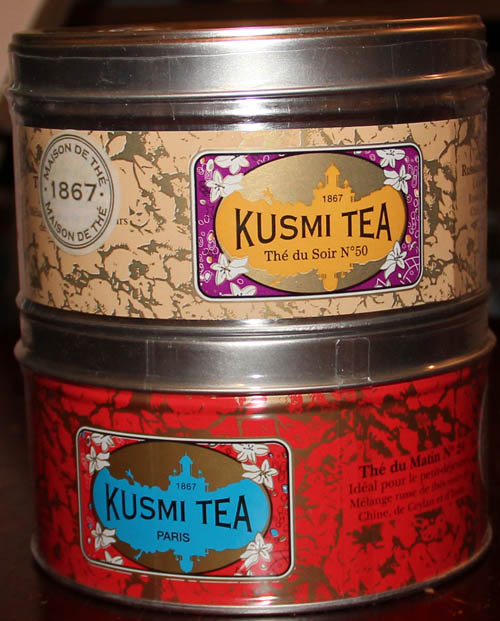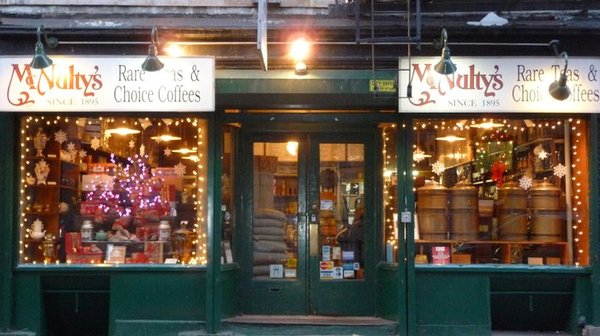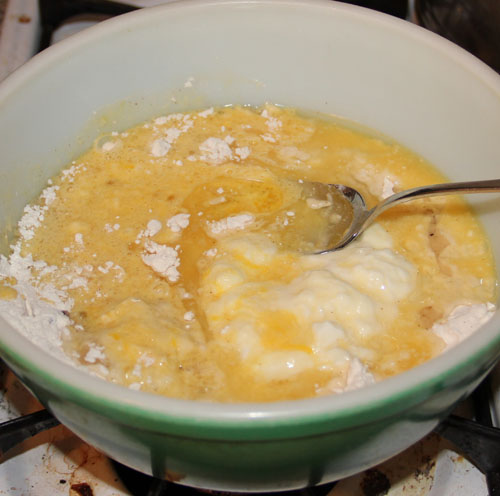Kusmi Tea, depuis 1867
September 18th, 2011
I can live quite happily without most indulgences, but the occasional tin (or two) of Kusmi Tea is one that I would be loathe to forgo.

I first tasted Kusmi’s Russian Evening Blend a few years ago at a cafe in Hell’s Kitchen. It was so enticing: complicated yet delicate, with a faint top note of roses. Having never seen the Kusmi brand before, I took the tag from the tea bag and carried it around in my wallet (it’s still there, knocking about in my change purse) so I’d remember the name. I resolved to look for a box on my next trip to the local coffee shop. To my surprise, they didn’t carry it. Neither did any of the grocery stores in our area. Yes, I know grocery stores rarely carry really good tea, but even the SoHo shops didn’t have it!
I mentioned my quest to an accomplice who also loves tea, and happens to be descended from Russian Nobility. He told me the story of the Kousmichoff family and their legendary tea house, begun in Russia in 1867 and later moved to Paris when it became politically expedient. I won’t attempt to recreate his version here, as I could never do it justice. Instead, I’ll point you to the official Kusmi Tea web site. By this time, my curiosity was thoroughly piqued. So I made it my quest to find a source in New York City. I eventually learned that only one shop (at that time there was but one — now there are more) in the City carried the Kusmi line.

McNulty’s, pictured here at Christmas, courtesy of someone who posted this photograph online, has been a mecca of the West Village since 1895. The interior furnishings are as old as the store — and equally charming. And they carry a full selection of Kusmi Tea, either loose in tins, or sewn into little muslin bags.
Russian Evening remains my favorite, taken either plain, with a little honey and lemon, or with a swirl of cherry preserves. I am also very fond of Russian Morning — a smooth and smokey blend beside which the average Irish Breakfast tastes like peat moss — best with a drop of cream. Now that I have my dear little single-serving teapot, courtesy of Miss R. K.’s recent sale, it will be even easier to brew a cup of Kusmi.
Top-Secret Tea
July 10th, 2011
Last Friday, I finally assembled all the ingredients for my new tea blend — which we plan to sell at the museum where I work, along with a booklet of mid-19th century tea lore that I compiled and edited earlier in the year. It’s based on a 19th-century tea blend found in one of the books I consulted while editing the little monograph.
I made a pot of the tea after Saturday’s dinner, and served it along with some left-over tart shells filled with cherry preserves. My goodness, it was delicious. It’s light, smooth, delicate, flavorful, and a bit sweet, all at once. Like very good first-flush Darjeeling, only not so ethereal. I tried it first plain, and then added milk. It was lovely both ways, and I think it would stand up just as well to lemon.
In fact, it was so incredibly good that I’ve decided to keep the blend a secret. You’ll just have to buy a packet (and a booklet) from the museum’s online gift shop — as soon as I’ve put it up for sale. Once it’s available, I’ll post the link. Until then, you can salivate. And (m)ooh and ahh over my adorable cow-shaped milk pitcher.
Secret of the Scone
January 30th, 2011
My Scottish and Irish forebears must look down from Brigadoon and smile as they see me baking scones nearly every week. Oddly enough, the recipe I use was given to me by Auntie Mary, from the Slovenian side of the family.
Auntie Mary is a phenomenal baker of the old school. Her scones are light and fluffy, her pies are rich and flaky, and her quick breads are beyond compare. Here is the original recipe, a closely guarded secret until this moment; I even won a ribbon at the County Fair with a batch of these scones, many years ago.

Auntie Mary’s Scones
Sift Together
2 Cups Flour
2 Tablespoons Sugar
1 Tablespoon Baking Powder
1/2 Teaspoon Salt
1/4 Teaspoon Baking SodaStir In (Optional)
1/2 Cup RaisinsAdd
1/2 Cup Sour Cream
1/3 Cup Milk
1/4 Cup Oil
1 Egg, Slightly BeatenStir ingredients until just blended. Turn out the dough onto a slightly floured board and knead gently, usually just a few strokes are sufficient to perfect the mixing. Form into a flattened circle, about an inch thick. Cut into eighths. Bake on an ungreased tray at 425 degrees for 10-15 minutes, or until lightly browned.
The result is a toothsome teatime treat. Smother them in clotted cream (or whipped cream mixed with a little sour cream if you can’t get your hands on real, fresh clotted cream) and berry jam. Repeat as desired.

The true art of the scone, however, is in the variations, usually invented on the spur of the moment. Here are a few I often use. Try them with my blessing — or better still, come up with your own.
- Leave out the sugar, substitute fruit juice (I like orange) for the milk
- Substitute whole milk yogurt for the sour cream
- Add cinnamon and/or nutmeg to the dry ingredients
- Mix a few Tablespoons of dried coconut or ground flaxseed with the dry ingredients
- Vary your dried fruit — cranberries, blueberries, cherries, or try all three
- Use fresh fruit — drained, crushed pineapple is delicious — but be sure to reduce the other liquids
- Add broken nutmeats
- Brush the tops of the scones with milk or juice and sprinkle with coarse sugar before baking

Don’t forget to make a pot of tea! Or a mango tea latte…



